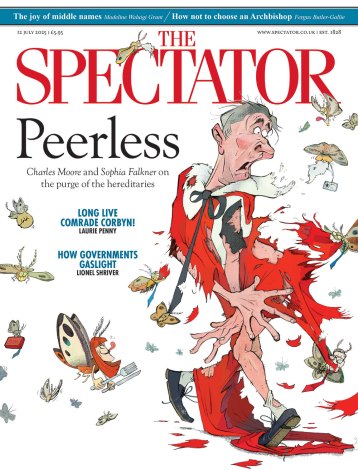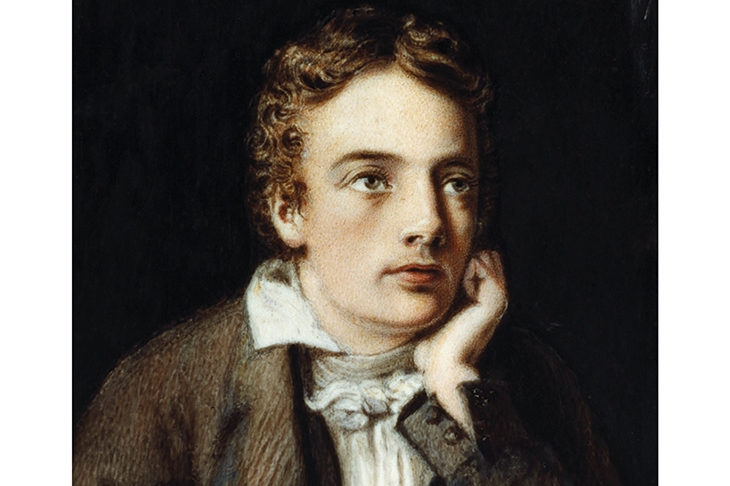Keats long ago became the meaningless emblem of poetic genius. When the poet Amanda Gorman appeared at President Joe Biden’s inauguration, both detractors and admirers wanted to set her against the highest possible comparison. They didn’t reach for the US’s new Nobel laureate, Louise Glück. They went for Keats: either ‘Amanda Gorman is Keats-level brilliant’ or ‘Well, it’s not exactly Keats’. But what is Keats, exactly?
It seems to me that there is a difference between the 5ft English poet who worked for a very few years before dying at 25 in 1821, and the idea of ‘Keats’. The idea of ‘Keats’ encompasses a great love story with Fanny Brawne; some beautiful, dreamy phrases; and a couple of impressive philosophical statements which, as it happens, fit very well into a tweet. There is ‘A thing of beauty is a joy forever’, and the other — ‘Beauty is truth, truth beauty.’ If that were all, I don’t think Keats would claim our attention, since both those apothegms are demonstrably false. Things the 1800s thought possessed beauty have long stopped giving anyone joy, and there are plenty of essential truths, such as the detail of natural selection or the Thirty Years War, where beauty is entirely dispensable.
Lucasta Miller’s task, which she carries out very successfully, is to strip away what we think when we think about Keats. She presents him to us as he would have struck his first readers. There is such a glutinous layer over Keats, the product of decades of entranced readers. In P.G. Wodehouse’s Mike (1909) the cricket captain Wyatt offers a glass of water, saying:
Oh, for a beaker full of the warm south, full of the true, the blushful Hippocrene! Have you ever tasted Hippocrene, young Jackson? Rather like ginger-beer, with a dash of raspberry-vinegar. Very heady.
The ‘Nightingale’ ode actually begins with an extended consideration of whether to get seriously drunk or not
Kipling’s near-contemporary story ‘Wireless’ (1902) attempts to remove some of this familiarity by imagining the recomposition or transmission of some of the greatest poems by a modern-day druggist. The attitudes of sophisticated readers were for long summarised by Auden’s faintly patronising lines in the ‘Letter to Lord Byron’: ‘Like other boys, I lost my taste for sweets/Discovered sunsets, passion, God and Keats.’
The only way out of this is Miller’s approach, which is to read what Keats actually wrote, and talk about it — to place yourself in the position of Keats’s first readers, too, and understand why they felt as they did. On their original publication, Keats’s poems struck readers as indecent, excessive, second-hand, incoherent and improper. When, much later in the century, his incomparable love letters to Fanny Brawne were published, the reaction among readers who had grown used to the poems was exactly the same. People using Keats’s name in 2021, either to do down or big up a new young poet, may have forgotten that one of his best poems recommends breaking into a girl’s bedroom before drugging and raping her as a wooing tactic. The poem generally thought the most beautiful, the ‘Nightingale’ ode, actually begins with an extended consideration of whether to get seriously drunk or not. Keats is much odder and more shocking than ‘Keats’ is, and if people had got much beyond the first line of ‘Endymion’, they would know that. What is needed from time to time is what Christopher Ricks achieved in the best of all books about the poet, Keats and Embarrassment: a sense of just how strange this great poet is.
Miller’s approach is to read nine of Keats’s greatest poems in chronological order, from the Homer sonnet and ‘Endymion’ to the ode ‘To Autumn’ and the ‘Bright Star’ sonnet. Close reading teases out much of the oddity, and goes on to root it in the circumstances of Keats’s life. It is as well to remember, for instance, that the precision of detail about the decaying corpse the heroine digs up in ‘Isabella’ comes from a proper medical training. As one of Kipling’s characters in ‘Wireless’ comments on a stanza in ‘The Eve of St Agnes’: ‘Anybody could see he was a druggist from that line about the tinctures and syrups.’
There is so much that is picturesque, mock-medieval or classical in Keats that it’s well to be reminded just how modern a figure he was. It’s sometimes easier to see this from his hostile reception by critics. To them, he was vulgar in a way that would not have been possible in a poet 50 years earlier. Patrons always liked quite untutored poets, sometimes installing them in their garden grottoes as Queen Caroline did poor Stephen Duck in the 1730s. What was new was a poet of ordinary but quite prosperous origins — Keats was the son of a successful ostler — with a less traditional sort of education. His writing was not vulgar in the sense that anyone else could have done it; rather it was grossly improper in its frank venturing beyond what could be decently described. Keats talked about the wetness, slipperiness, decay and substance of bodies in ways that betrayed his experience of a dissection; he stared, interested, at ladies blushing; he ventured into private spaces and relished the violation of class barriers without apology. ‘Vulgarity’ was a newish concept, Lady Elgin saying of Emma Hamilton: ‘She is a Whapper!…And I think her manner very vulgar.’ In that vulgarity lies half Keats’s energy.
Moreover, he had the sort of education that skated over the surface of knowledge, or so readers insisted. Like Shakespeare, he had no Greek, and his classical poems came straight from his favourite book, Lemprière’s 1788 dictionary of classical mythology and history. Deploring the use of Lemprière as a crib, a substitute for knowledge, went on much longer than might be thought. In a famous review of Auden from 1960, Philip Larkin sneered at his poetry as ‘a wilful jumble of Age-of-Plastic nursery rhyme, ballet folklore and Hollywood Lemprière’. In Keats’s case, the lack of rigid investigation unleashed his fantasy; Byron, with his education and travel, could never have written the lines about the magic casements in the ‘Nightingale’ ode, or ‘Lamia’. Neither could he have matched the rapturous evocation of what imperialist plunder might bring to the market in the verses about Isabella’s brothers’ business.
This excellent book marks the 200th anniversary of the poet’s death. It enters an already crowded market of Keats biographies, but earns its place through its firm basis in precise reading. Miller is empathetic, and relishes Keats’s best phrases, such as those on his first encounter with Fanny Brawne — ‘beautiful and elegant, graceful, silly, fashionable and strange….’ She is patient with the (to me) increasingly ludicrous critical readings of ‘To Autumn’ as really about the Peterloo massacres. She persuasively shows, however, that the predominantly indigenous word choices produce as politically charged a celebration of Englishness as the famous passage in Emma about ‘English verdure, English culture, English comfort’. If you read the words, Miller persuades us, whether of the poems or the great letters, Keats is there, as new as ever.
What would have happened to Keats? It’s impossible to know, but I have a perhaps controversial theory. Miller rightly says that he had a ‘constitutionally empathetic nature’, unusual among poets. He went on looking at things when most writers turn away, through decency or good taste. He was a very accomplished handler of narrative; the letters often show an incisive analyst of character and some masterly stretches of observed behaviour and dialogue. If he had lived, his early middle age would have coincided with a great expansion of the novel; if he had survived to the age of 80, he would have outlived Dickens. It’s not inconceivable that, like Walter Scott’s before him, his career as a poet would have given way to a long and rich one as a novelist of unusual range, expressive power and intense curiosity. Just a thought.






Comments